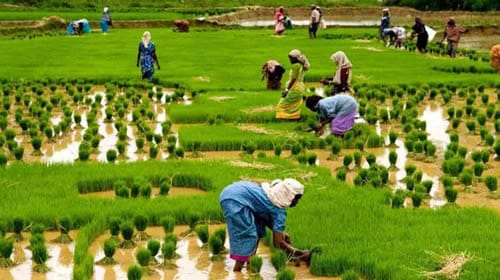Food, they say is the basic need of life. Searching for a grant can be very exhausting. The most frustrating part is that almost at the end of the registration, you get to find out you did not qualify for a very flimsy reason. Not to worry, this post basically narrows your search range and exposes you to agriculture grants within your reach. Also, you will be able to get first-hand information concerning the opening and closing dates.
But, to get that business plan or proposal funded, you would need to search for grants in the right niche.
For instance, for an agriculture-based business idea or innovation, you need to search for Agriculture grants -e.g. the IFAD (International Fund for Agricultural Development). Shortly, we’ll go over the top 5 agricultural grants in 2023 plus a couple of popular agriculture programs you shouldn’t miss.
List of Agricultural Grants
Listed below are five top agricultural grants in 2023.
#1. Common Fund for Commodities
The Common Fund for Commodities (CFC) is a financial institution that provides agricultural grants to diversify and improve the production of commodities globally.
Furthermore, the CFC aims to alleviate poverty mainly in developing countries through strategic projects. These developing countries however include:
- Southeast Asia and Pacific Islands: Papua New Guinea, Myanmar, Indonesia, Philippines, Laos, Malaysia, Samoa, Thailand.
- East Asia: China, North Korea
- South Asia: Nepal, Sri Lanka, Bhutan, India, Maldives, Pakistan, Bangladesh.
- Eurasia and Central Asia: Afghanistan
- Eastern Europe and Russia: Russia
- The Middle East and North Africa: Saudi Arabia, Algeria, Egypt, Syria, Iraq, Kuwait, Yemen, Morocco, Tunisia, United Arab Emirates
- Sub-Saharan Africa: Nigeria, Burkina Faso, Swaziland, Benin, Cote d’Ivoire, Zambia, Burundi, Cameroon, Chad, Comoros, Central African Republic, Sierra Leone, Somalia, Angola, Tanzania, Togo, Sudan, Uganda, Zimbabwe, Congo, Dem Rep of Congo, Djibouti, Botswana, Senegal, Equatorial Guinea, Ethiopia, Gabon, Gambia, Ghana, Cape Verde, Guinea, Guinea-Malawi, Bissau, Kenya, Lesotho, Madagascar, Mali, Mauritania, Mozambique, Niger, Rwanda, Sao Tome, and Principe
- Latin America and the Caribbean: Costa Rica, Guatemala, Venezuela, Argentina, Brazil, Colombia, Cuba, Nicaragua, Ecuador, Haiti, Honduras, Jamaica, Mexico, Peru, Trinidad and Tobago
Also, this agricultural grant covers a wide range of commodities – with 80% in the agricultural sector and a few others in minerals. Click here for details about the program
Application Process
CFC’s applications come in two stages. The first comprising of the submission of detailed proposals and applications. Then after a thorough screening by CFC, successful applicants make it to the next stage.
Deadlines
The Common Fund for Commodities applications is currently open.
The 21st Call for Proposals has been announced with the applications scheduled to close by 15th September 2022. Click here for details and instructions.
Read Also: 25+ SME GRANTS FOR AFRICANS (Updated!!!)
#2. International Fund for Agricultural Development
The International Fund for Agricultural development is a financial agency under the umbrella of the United Nations.
The IFAD provides agriculture grants mainly for capacity development and research in natural resources and related programs to tackle poverty in rural areas. Also, they organize these grants at different levels ranging from the national level to the global level.
Furthermore, besides agricultural grants, the International Fund for Agricultural development also provides low-interest loans to aid the poor agricultural infrastructure and manage natural resources in developing countries. These loans are only accessible to IFAD’s member states on terms and conditions based on their financial strengths. So indirectly only agricultural organizations within these member states are eligible.
Eligibility
So, eligibility for this grant starts with member countries which include:
- Southeast Asia and Pacific Islands: Thailand, Solomon Islands, Cambodia, Tonga, Philippines, Fiji, Indonesia, Laos, Malaysia, Myanmar, Papua New Guinea, Samoa, Timor-Leste, Marshall Islands, Kiribati, Vietnam
- East Asia: Mongolia, China, North Korea
- South Asia: Nepal, Sri Lanka, Bhutan, India, Maldives, Pakistan, Bangladesh.
- Eurasia and Central Asia: Georgia, Afghanistan, Kazakhstan, Armenia, Tajikistan, Azerbaijan, Iran, Kyrgyzstan, Turkey
- Eastern Europe and Russia: Moldova, Albania, Macedonia, Bosnia and Herzegovina, Croatia
- The Middle East and North Africa: Jordan, United Arab Emirates, Algeria, Oman, Egypt, Iraq, Qatar, Kuwait, Lebanon, Tunisia, Libya, Morocco, Saudi Arabia, Syria, Yemen
- Sub-Saharan Africa: Djibouti, Ghana, Togo, Gambia, Angola, Burkina Faso, Burundi, Guinea-Bissau, Sierra Leone, Cameroon, Madagascar, Central African Republic, Malawi, Comoros, Somalia, Congo, Equatorial Guinea, Eritrea, Benin, Ethiopia, Gabon, Guinea, Kenya, Lesotho, Liberia, Mali, Sudan, Mauritania, Mozambique, Namibia, Niger, Nigeria, Rwanda, Sao Tome and Principe, Senegal, Dem Rep of Congo, Seychelles, South Africa, Cape Verde, South Sudan, Swaziland, Chad, Tanzania, Botswana, Uganda, Zambia, Cote d’Ivoire, Mauritius, Zimbabwe
- Latin America and the Caribbean: Haiti, Antigua, and Barbuda, Paraguay, Bahamas, Bolivia, Brazil, Chile, Saint Vincent, and the Grenadines, Costa Rica, Uruguay, Cuba, Dominica, Mexico, Ecuador, Grenada, Nicaragua, Guyana, Jamaica, Panama, Argentina, Peru, Saint Kitts and Nevis, Barbados, Saint Lucia, Belize, Colombia, Suriname, El Salvador, Trinidad and Tobago, Venezuela, Honduras, Guatemala, Dominican Republic
Also, the International Fund for Agricultural Development manages a variety of grants which are divided into large and small grants.
- The large grants support international agricultural research and other international efforts for rural development at regional levels. However, these grants are within the range of US$500,000 to US$2 million.
- On the other hand, smaller grants cover capacity building, knowledge networks, rural innovations, and policy advocacy. (<US$500,000)
Deadlines
International Fund for Agricultural Development announces calls for proposals when funding is available. Click here for updates and application process.
P.S: The link takes time to load so be patient.
Read Also: Federal Government Business Grants
#3. Regional Fund for Agricultural Technology (Fondo Regional de Tecnología Agropecuaria, FONTAGRO)
The Regional Fund for Agricultural Technology is a platform that promotes research and technological innovations in the agricultural sector by providing agriculture grants. But this grant is only accessible to Latin Americans and the Caribbean.
Furthermore, FONTAGRO is a collaboration between the Inter-American Development Bank and the Inter-American Institute for Cooperation. These two, however, provide administrative and legal resources.
Although focus areas of this agriculture grant include research in:
- Agricultural productivity
- Innovations in agri-food chains
- Agricultural policies
- Institutional strengthening
- Agricultural competitiveness
- Natural resources
However, there are also few diversions into natural and environmental resources-based projects. Plus funding from this grant is usually within the range of US$100,000 to US$500,000 for projects of up to four years.
Eligibility
For the most part, recipients of FONTAGRO are usually national agricultural research organizations of its member states, collaborating with partners at Consultative Group on International Agricultural Research (CGIAR), national universities and research institutes, and others.
Conversely, these member countries include:
Latin America and Caribbean: Argentina, Bolivia, Chile, Colombia, Costa Rica, Dominican Republic, Ecuador, Honduras, Nicaragua, Panama, Paraguay, Peru, Uruguay, Venezuela
Note: Spain is also a member country.
Read Also: Funding Opportunity; Global Green Grant Fund
Application
FONTAGRO’s website occasionally announces calls for proposals, terms of reference, application guidelines, selection criteria, application forms, budget forms, and calendar deadlines.
PS: To Convert the Website’s language to English, just click on the language in the top left corner.
#4. Alliance for a Green Revolution in Africa
The Alliance for a Green Revolution in Africa (AGRA) is a movement that provides funding for agricultural research, capacity building, and field projects in Sub-Saharan Africa. AGRA aims at providing agriculture grants to improve small-scale agriculture.
Furthermore, AGRA was founded by the Bill & Melinda Gates Foundation in collaboration with the Rockefeller Foundation. However, funding occasionally comes in from African national governments, foundations, financial institutions, companies, and so on.
Though, the focus areas of the AGRA program include:
- Agricultural development and research
- Enhanced agricultural seed
- Soil health and fertility
- Improved markets
- Strengthened agricultural policies
- Unwavering Support from farmers’ organization
- Innovative financing
But while funds disbursed by AGRA are not fixed, a more substantial part of these grants are usually within the range of US$100,000 and over a million dollars.
Eligibility
African agencies, institutes for agricultural research, private African seed companies/universities, and research institutes are significant beneficiaries of this agriculture grant.
In other words, to receive any form of consideration, you must fall within these categories.
For more details on eligibility, click here.
Application
Competitive grantmaking has been ruled out by AGRA. However, they occasionally fund proposals after occasional calls for proposals. How to Apply
Read Also: Unsure Of Yourself? How To Pitch For Grants
#5. Nestle Foundation
The Nestle foundation focuses on providing agriculture grants for research in the following areas:
- Child and Maternal nutrition
- Agricultural development (especially in areas like food policies, food production, and food technology)
- Macro and Micro-nutrient deficiency
- Nutrient imbalances
- Interactions between infection and nutrition
- Promotion of nutritional education and health.
Also, the foundation supports research proposals that are beneficial to developing countries.
Types of Nestle Agricultural Grants
- Training Grants (which disburses US$20,000 for one or two years)
- Pilot Grants (which disburses US$20,000 for one or two years)
- Small Research Grants (which disburses US$50,000)
- Large Research Grants (which disburses US$100,000 per year for up to three years)
- Re-entry Grants (which disburses US$50,000 for up to three years)
Application
The grant-making process of this agriculture grant is in two stages. Firstly, the initial stage involves the submission of Letters of Intent (LOI).
Secondly, these letters are reviewed, and successful applicants are invited to submit detailed proposals.
However, full guidelines for the submission of LOIs are outlined on the Official website.
Deadlines
There are no fixed deadlines for the submission of Letters of Intent. It can be submitted at any time of the year.
But for more information on DECISION ANNOUNCEMENTS and GRANT STARTING DATES, Click here.
Read Also: GRANT WRITERS: Certification, Job Description & All You Need
Top Agriculture Grant Funding Programs in the US
The following are some of the most popular agriculture grants/programs in the US. However, this covers both loan and grant options available to any farmer out there.
#1. Farm Loans
FSA provides direct and guaranteed farm ownership and operating loans to family-sized farmers and ranchers who are unable to access commercial credit from a bank, Farm Credit System institution, or another lender. Loans and sometimes, grants from the FSA can be used to buy land, animals, equipment, feed, seed, and supplies. Loans can also be used to build structures or improve farms.
#2. Rural Development Loan and Grant Assistance
USDA Rural Development collaborates with rural communities to fund programs that provide housing, community amenities, business guarantees, utilities, and other services to rural America. The USDA provides technical help as well as financial support to rural enterprises and cooperatives in order to develop excellent jobs in rural areas. Rural Creation advances the President’s National Energy Policy and, eventually, the nation’s energy security by engaging rural America’s entrepreneurial spirit in the development of renewable energy and energy efficiency improvements. Rural Development collaborates with low-income individuals, state, local, and tribal governments, as well as private, nonprofit, and user-owned cooperatives.
Read Also: FARM GRANTS FOR FEMALES 2023 (21+ grants)
#3. Housing Assistance
The USDA offers low- and moderate-income rural Americans the opportunity to become homeowners through a variety of loan, grant, and loan guarantee programs. Individuals can also use the funds to make critical modifications to their homes, such as making them more livable, safe, and sanitary. USDA Multi-Family Housing Programs provide Rural Rental Housing Loans to enable low-income, low-income, and moderate-income families, the elderly, and people with disabilities with affordable multi-family rental housing. In addition, qualifying families can receive rental help.
#4. Beginning Farmers and Ranchers
The USDA, through the Farm Service Agency, makes direct and guaranteed loans direct and guaranteed farm ownership (FO) and operating loan (OL) monies to beginning farmers and ranchers.
#5. Livestock Insurance
USDA assists producers in managing business risks. The Risk Management Agency (RMA) of the USDA’s objective is to promote, support, and regulate appropriate risk management solutions in order to preserve and strengthen the economic stability of America’s agricultural producers. RMA operates and supervises the Federal Crop Insurance Corporation as part of this mandate (FCIC).
RMA is divided into three sections: Insurance Services, Product Management, and Risk Compliance. The policies are sold and serviced by seventeen private-sector insurance companies. RMA establishes and/or authorizes premium rates, manages premium and expense subsidies, approves and supports products, and reinsures companies. RMA also funds educational and outreach programs, as well as risk-related conferences.
#6. Federal State Marketing Improvement Program
This matching grant program, also known as FSMIP, provides matching funds to state departments of agriculture and other appropriate state agencies to aid in the exploration of new market opportunities for food and agricultural products, as well as to encourage research and innovation aimed at improving the efficiency and performance of the marketing system.
#7. Specialty Crop Block Grant Program
SCBGP funds can be obtained in order to improve the competitiveness of specialty crops. Fruits and vegetables, tree nuts, dried fruits, and nursery crops are examples of specialty crops (including floriculture).
Read Also: List of Federal Government Grants 2023, Updated!!!
#8. Farmers Market Promotion Program (FMPP)
The FMPP was established as a result of a recent revision to the 1976 Farmer-to-Consumer Direct Marketing Act. The FMPP-authorized grants are intended to assist in the improvement and expansion of domestic farmers markets, roadside stands, community-supported agriculture initiatives, and other direct producer-to-consumer market opportunities.
#9. Organic Cost Share Program
AMS manages two cost-sharing schemes for organic certification. Each program offers cost-sharing help to organic farmers and/or handlers through participating states. Recipients must be certified or have their certification renewed by a USDA-accredited certifying agent (ACA).
How Do I Ask for Grant Money?
Steps for How to Ask for a Grant
- Find grant prospects that fit.
- Visit the websites of the people you want to get grants from every so often.
- Call the person in charge to make sure you meet the requirements.
- Make a letter of intent or a grant proposal.
- Follow the grantor’s instructions to the letter.
What Grants Are Available for Farming?
The following are available grants for farming;
- Farm Service Agency (FSA) Loans.
- Housing Assistance.
- Beginning Farmers and Ranchers.
- Crop and Livestock Insurance.
- Federal State Marketing Improvement Program.
- Specialty Crop Block Grant Program.
- The Farmers Market Promotion Program.
- Organic Cost Share Program.
What Are the 4 Types of Grants?
There are only four major categories of grant funding. Basically, these include; descriptions and examples of competitive, formula, continuation, and pass-through grants.
What Is the Most Common Grant?
The Program/project grants. This type of grant is the most common. Grants for programs or projects say that the money can only be used to help the program or project you wrote about in your proposal.
How Much Money Do You Need to Start a Small Farm?
The cost of starting a small farm ranges from $600 to $10,000. However, the cost of beginning a farm is mainly determined by the outlook, location, kind of equipment, size of the farm, type of labor required, invested time, farm goods, and whether or not you already own a property.
Where Do the Most Small Farmers Borrow Their Money From?
Most small farmers have to take out loans to get the capital they need. They borrow money from big farmers, moneylenders in the village, or traders who sell things used in farming.
What Grant Is Easiest to Get?
Educational grants and scholarships are by far the easiest types of grants to get. People in college who meet different requirements can apply for these.
- Grassroots Business Funds – Africa, Asia & Latin America
- Indiana Small Business Grants: 17+ Best Funding Options for Any Business
- FLORIDA SMALL BUSINESS GRANTS: Best 13 Tips to Increase Your Chances (+Detailed List)
- CAL GRANT B: All You Should Know Before Applying (+ Free Tips)
- SBA GRANT: How to Apply for SBA Grant, Simplified!!! (+Detailed Guide









6 comments
Hello.
I am BAKKA WILBER from Uganda in Africa. I have tried looking for funding from every source but in vain. I really want to start a herb farm in my country and the entire project costs about $23,500 however, if only i could be given $1500 to start small, it would really be a huge breakthrough to start. Hope you will assist me in any way you can. Thanks
You can subscribe to our grants update so we can inbox you directly on all grants or funding opportunities related to your business niche. While we recommend you get started with what you have, We are also happy to know you are passionate about what you.
I would like to find out and apply for agriculture grants
Greetings, my interest is in Plantains & Allied Agro-Produce and Services.
Hello, my name is oyugi jacob from Kenya,, I am doing poultry farming but in small scale I am looking for grants to expand my production,, I hope you will consider me.
Hello Jacob, Business Yield at the moment does not offer grants. We publish grants and other financial aid opportunities to help businesses access funding. I hope you take advantage of such publications.
Thank you, Jacob!